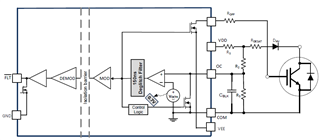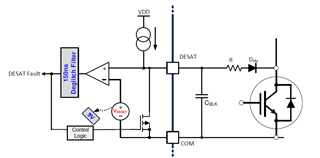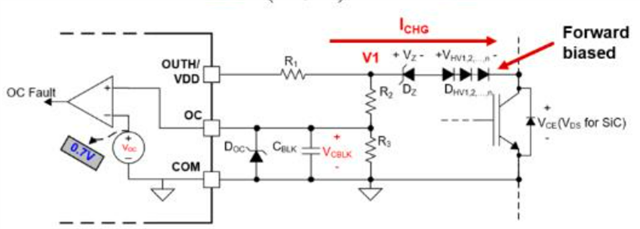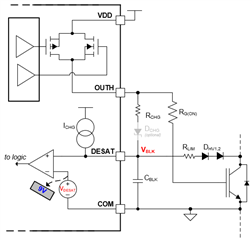Other Parts Discussed in Thread: UCC21732, UCC21750
This is in reference to the gate driver controller IC UCC21732 .
In case of short circuit or over current protection the IC has a modern approach, where an OC pin is available which can be configured to detect adverse SC situations. However, this functionality can’t be used with selected SiC MOSFET because of unavailability of SenseFET provision in MOSFET. The other options left are DESAT and shunt resistor method.
In case of shunt resistor, there are obvious limitations of high power loss, low noise tolerance, parasitic inductance and non-galvanic isolation. So, with this constraints the only available option is DESAT protection. But, with the selected controller IC (UCC21732) the configuration is not straight forward, as the current source to charge the CBLK is not from the IC, an external source has to be configured.
The below image gives a glimpse on the DESAT configuration. It would be nice if you can provide your insight for the calculation of various resistor as the usage of the gate driver and overcurrent protection is very crucial for our application.

On other hand, the selected controller family has other IC (UCC21750) which has dedicated DESAT configuration. But, the there will be tradeoff between 2-level turn-off and soft turn-off functionality.

So, which part number should be selected to provide DESAT protection owing to the advantage of 2-level turn-off in the other.
Also, Calculations are performed for the normal DESAT configuration for UCC21750. However, the internal reference voltage is 9 V for the trip and the VDS at which short circuit takes place is 1.5 V. So, the voltage threshold can only be set by taking RDESAT of higher value and at least 4 diode is series. Is this a viable approach? Also, the blanking time is 1.8 us. Is this tBLK more for SiC protection?

Kindly provide insights on the above points.



